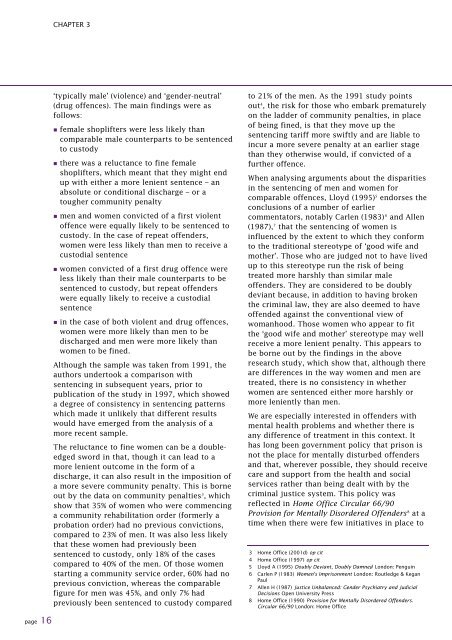Women who challenge - Nacro
Women who challenge - Nacro
Women who challenge - Nacro
- No tags were found...
You also want an ePaper? Increase the reach of your titles
YUMPU automatically turns print PDFs into web optimized ePapers that Google loves.
CHAPTER 3‘typically male’ (violence) and ‘gender-neutral’(drug offences). The main findings were asfollows:• female shoplifters were less likely thancomparable male counterparts to be sentencedto custody• there was a reluctance to fine femaleshoplifters, which meant that they might endup with either a more lenient sentence – anabsolute or conditional discharge – or atougher community penalty• men and women convicted of a first violentoffence were equally likely to be sentenced tocustody. In the case of repeat offenders,women were less likely than men to receive acustodial sentence• women convicted of a first drug offence wereless likely than their male counterparts to besentenced to custody, but repeat offenderswere equally likely to receive a custodialsentence• in the case of both violent and drug offences,women were more likely than men to bedischarged and men were more likely thanwomen to be fined.Although the sample was taken from 1991, theauthors undertook a comparison withsentencing in subsequent years, prior topublication of the study in 1997, which showeda degree of consistency in sentencing patternswhich made it unlikely that different resultswould have emerged from the analysis of amore recent sample.The reluctance to fine women can be a doubleedgedsword in that, though it can lead to amore lenient outcome in the form of adischarge, it can also result in the imposition ofa more severe community penalty. This is borneout by the data on community penalties 3 , whichshow that 35% of women <strong>who</strong> were commencinga community rehabilitation order (formerly aprobation order) had no previous convictions,compared to 23% of men. It was also less likelythat these women had previously beensentenced to custody, only 18% of the casescompared to 40% of the men. Of those womenstarting a community service order, 60% had noprevious conviction, whereas the comparablefigure for men was 45%, and only 7% hadpreviously been sentenced to custody comparedto 21% of the men. As the 1991 study pointsout 4 , the risk for those <strong>who</strong> embark prematurelyon the ladder of community penalties, in placeof being fined, is that they move up thesentencing tariff more swiftly and are liable toincur a more severe penalty at an earlier stagethan they otherwise would, if convicted of afurther offence.When analysing arguments about the disparitiesin the sentencing of men and women forcomparable offences, Lloyd (1995) 5 endorses theconclusions of a number of earliercommentators, notably Carlen (1983) 6 and Allen(1987), 7 that the sentencing of women isinfluenced by the extent to which they conformto the traditional stereotype of ‘good wife andmother’. Those <strong>who</strong> are judged not to have livedup to this stereotype run the risk of beingtreated more harshly than similar maleoffenders. They are considered to be doublydeviant because, in addition to having brokenthe criminal law, they are also deemed to haveoffended against the conventional view ofwomanhood. Those women <strong>who</strong> appear to fitthe ‘good wife and mother’ stereotype may wellreceive a more lenient penalty. This appears tobe borne out by the findings in the aboveresearch study, which show that, although thereare differences in the way women and men aretreated, there is no consistency in whetherwomen are sentenced either more harshly ormore leniently than men.We are especially interested in offenders withmental health problems and whether there isany difference of treatment in this context. Ithas long been government policy that prison isnot the place for mentally disturbed offendersand that, wherever possible, they should receivecare and support from the health and socialservices rather than being dealt with by thecriminal justice system. This policy wasreflected in Home Office Circular 66/90Provision for Mentally Disordered Offenders 8 at atime when there were few initiatives in place to3 Home Office (2001d) op cit4 Home Office (1997) op cit5 Lloyd A (1995) Doubly Deviant, Doubly Damned London: Penguin6 Carlen P (1983) <strong>Women</strong>’s Imprisonment London: Routledge & KeganPaul7 Allen H (1987) Justice Unbalanced: Gender Psychiatry and JudicialDecisions Open University Press8 Home Office (1990) Provision for Mentally Disordered Offenders.Circular 66/90 London: Home Officepage 16
















